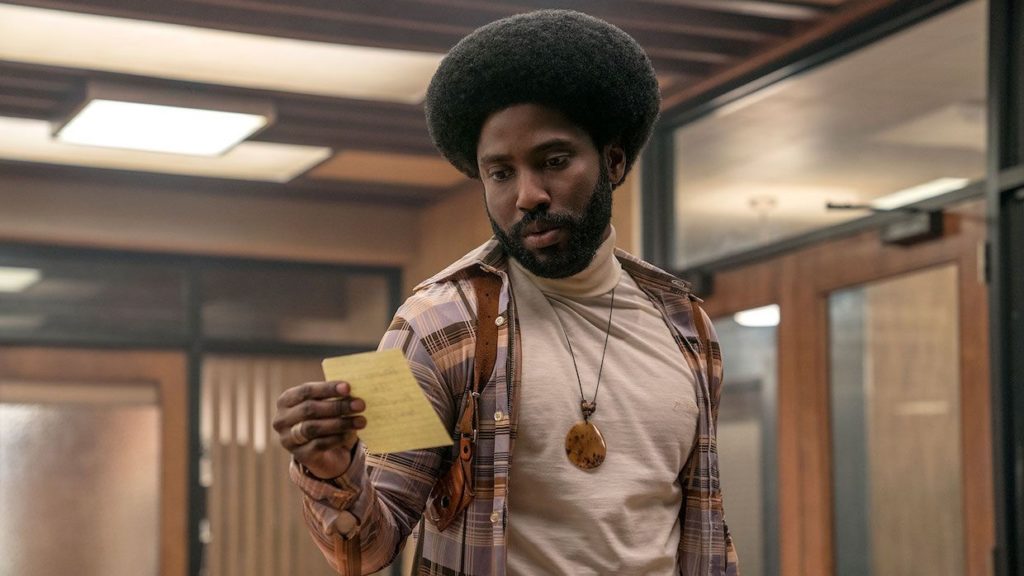“Dreams we dream alone is only a dream, but dreams we dream together is reality” – Yoko Ono, 1971

Fantasy is at the heart of Spike Lee’s film BlacKKKlansman (2018). This may be surprising at first since the story of Ron Stallworth is about very real and very urgent issues of race in this country. But it really does make sense, and a closer examination of the film, with this in mind, will undoubtedly allow the viewer to see just how useful fantasy is to articulating a political commentary. Lee himself has used this strategy numerous times (most effectively in Crooklyn) and it can be seen in even greater abundance in another recent release, Boots Riley Sorry To Bother You (2018).
Consider first the scene in which Ron (John David Washington) and Patrice (Laura Harrier) are taking a romantic stroll through a park. The couple discusses a few of Pam Grier’s films then Shaft (1971) and Super Fly (1972); each film representing a distinct and individual fantasy. For every title they discuss the poster for said film appears on either the right or left (and sometimes both) of screen, framing the couple who occupy the center of the frame. These visual “equations” make for a startling number of new images whose juxtaposition grounds the images of Ron and Patrice and Washington and Harrier within the context of renowned characters/actors of Black cinema. Literally Ron and Patrice converse about how these famous personas of the seventies relate to them on the soundtrack while Lee begins a visual dialogue whose focus is on these various films/characters as abstract ideas and signifiers. Lee invites us to look for Grier in Patrice/Harrier and Shaft in Ron/Washington. And just as we may find similarities between all of these characters we are just as likely to notice the differences and Spike Lee knows this. Obviously Ron is not the womanizing super cop John Shaft is, nor does he seek to become like him. Through this duality Lee manages to pinpoint what was constructive and what was destructive about these seminal films of the seventies.
But this image complex is not restricted to the scene at the park. Spike Lee reprises the iconography of the earlier scene in one of the last shots of the film (in terms of narrative). Ron and Patrice, guns in hand, go to Ron’s window via dolly (a trademark shot of Lee’s borrowed from Jean Cocteau), and see a burning cross in the distance. During the dolly to the window Ron and Patrice occupy the same 2/3rds of the frame the posters did earlier. But now they are poised in a manner recalling those posters as well. Suddenly, Ron and Patrice embody what was useful about those earlier films; their advocacy for Black culture, their tales of retribution against racism in all its forms (private/public, personal/political), etc. So, in the films last act, Lee has settled on the usefulness of those seventies films and dismissed their misogyny and their jingoism. The dolly shot to the window is just the beginning of the climactic sequence which itself reprises a network of images established earlier.
At the start of the films third act is a sequence which cross cuts from the Klansmen to the Black contingent of the Colorado College student government. The Klansmen are excitedly watching D.W. Griffith’s The Birth Of A Nation (1915) while the students hear from a guest speaker about the violent aftermath the film had on the Black community in shocking detail. Lee juxtaposes images of cheering Klansmen with the tearful, outraged faces of the students and images of Klansman in Griffith’s film with photographs of a Black boy who was violently murdered in the street after The Birth Of A Nation’s original release. This double configuration sets fantasy on one side (with the Klansmen) and grim reality on the other (with the students) but also establishes a circuit of criminal and victim. When Lee arrives at the sequence that opens with the dolly shot to the window he is no longer commenting exclusively on the past of the 1910s and 1920s as represented by The Birth Of A Nation. Similarly, now both sides are in a kind of “fantasy”. Throughout the film Lee has treated the Klansman as a group of mostly “idle dreamers” (though for most these dreams are nightmares) and Ron and Patrice as “actualizers”. In this moment though, in this sequence, the “fantasy” of Shaft and Coffy come ready to meet that of the burning cross. One should also note that not only do Ron and Patrice now personify that particular brand of Black Power, but they are also in motion and ready to strike while the Klansmen, in the proceeding shots, gaze passively at their most cherished symbol. The dueling fantasies can therefore be categorized as action vs. non-action, pre-civil rights movement vs. civil rights movement, and The Birth Of A Nation vs. blaxploitation.
The coda to BlacKKKlansman opens up this network of dueling ideologies with a meditation on the footage from the Unite The Right Rally in Charlottesville Virginia in 2017. Lee sees an obvious continuity here, but even more startling is the fact that the conflict no longer conforms to any easy categorization. The film suggested a victory through the realizing of “fantasy” then immediately does an about face and gives the audience a glimpse at the failure of that fantasy. Spike Lee is wiser than say Steven Spielberg and refuses to give the spectator any answers or closure. For Lee it is enough to pinpoint what does not work and why and to remind us all of just how much we have at stake.
